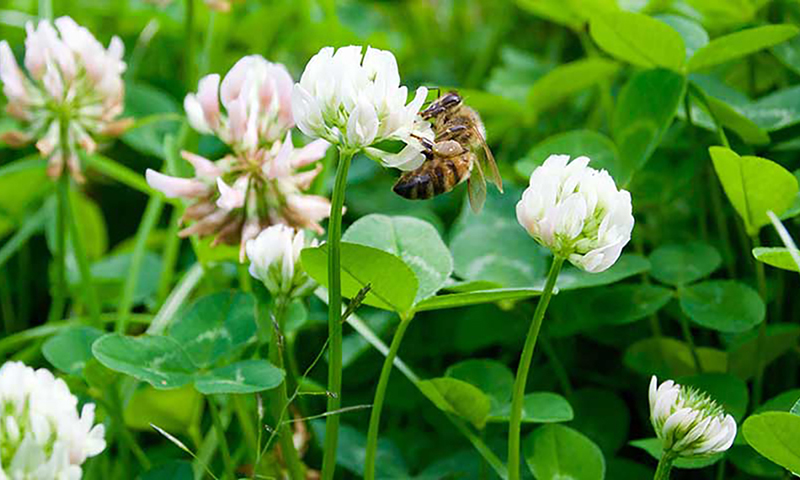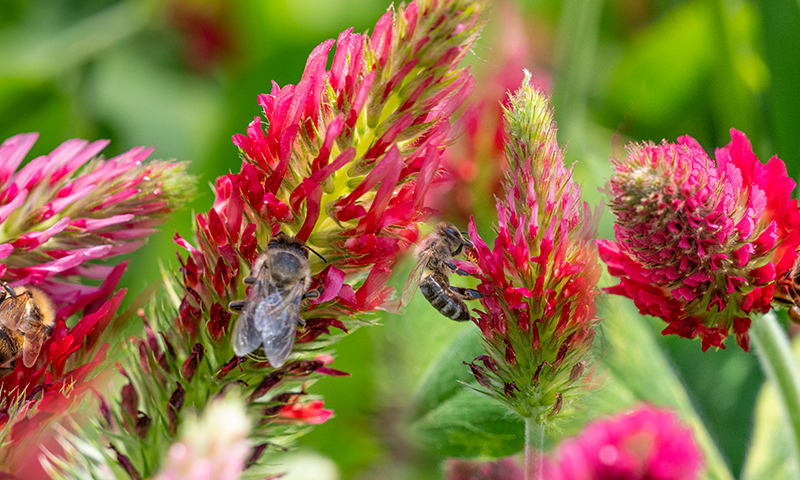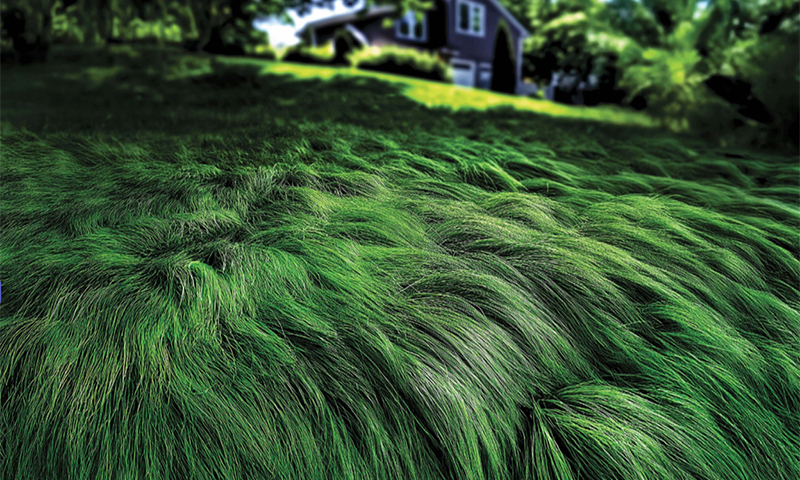Sustainable Lawn Alternatives
Ready to abandon the clean, green square and create a yard that celebrates your unique point of view? Nothing against turfgrass, conventional lawns and the people who love them. We love them, too. Healthy grass is beautiful, but your world is about options. There are other, even more sustainable ways to work with Mother Nature, conserve resources and have an amazing yard.
Sustainable lawn alternatives that require less water, fertilizer, pest control and mowing encourage biodiversity and have environmental benefits that extend far beyond your yard. These options for sustainable, unconventional lawns can get your imagination flowing and help you make your yard your own.
- Clover Lawns
- Habitat Havens
- No-Mow Meadow Grass
- Groundcover Plants
- Wildflower Meadows
- Drought-Tolerant Xeriscapes
- Foodscapes

Spend less time mowing and more time enjoying your yard with a grass and clover combo.
Clover Lawns
A lawn of low-growing clover mixed with lawn grasses delivers the best of both worlds. You can still enjoy that barefoot feeling, but you'll have weekends free to do more than mow.
Taller and more natural-looking than a traditional lawn, your clover-and-grass lawn only needs an occasional mowing to look its best. Clover also naturally fertilizes itself by fixing soil nitrogen, meaning less fertilizer to leach into groundwater and lakes.
Our Pennington Smart Seed Clover + Grass Mix turns your grass into an easy-care, sustainable lawn. This smart alternative combines self-sustaining clover with water-conserving grasses. You'll see quick results — even on slopes and hills — and a cloverly carpet that resists drought and disease and lasts for years.
Added bonus: Pollinators and other wildlife love to feed on clover blooms in sustainable pollinator lawns.

Boost backyard biodiversity with a habitat haven instead of grass.
Habitat Havens
If you’re head-over-heels for clover and wildlife, kick your lawn alternative up a notch with a habitat haven designed with biodiversity and wildlife in mind.
Pennington Durana White Clover seed — the same clover that pairs with traffic-tolerant lawn grass so well — makes a gorgeous self-fertilizing perennial clover carpet all its own. But don’t be shy about taking clovers and habitat a step higher to give wildlife, including wild birds, a place to call home.
Pennington Crimson Clover gives your alternative lawn a dash of drama in the form of fast-growing, deep crimson blooms that pollinators adore.
Your suburban wildlife refuge can reach even greater heights with Pennington Backyard Habitat seed mix. This easy-to-maintain mix of white, crimson and red clovers adds layers of color from ground level up to three feet tall. You’ll have bunnies, Bambi and even backyard hens (if you have them!) munching happily.

No-Mow Meadow Grass
When gorgeous green lawns still tug at your heartstrings, there’s still hope. Sticking with grass doesn’t have to mean weekends spent behind your trusty mower. Pennington No Mow Meadow Grass Seed Mix gives new meaning to lawns and lawn alternatives with slow-growing, low-maintenance turfgrasses.
You can elevate your Sustainable Lawn Care 101 lessons and keep your lawn green, but do it with a whole new look and feel. Instead of short and manicured, your no-mow meadow grass lawn delivers a wilder, softer look.
Blowing gently in a soft summer breeze or cascading down hills or slopes, no-mow meadow grasses are more about growing and flowing — not mowing. But if you do decide you want to mow garden paths or more, you can do that, too. It’s all about an alternative lawn that lets you be you.

Low-growing groundcovers turn lawns into living tapestries.
Groundcover Plants
Nature and nurseries are full of non-grass plants that like to lie low. Some types spread quickly. Others like to take it slow. But whatever their growth rate, they go sideways instead of up. That makes for great sustainable alternative lawns. Stick with one type of plant or create a living tapestry of low-growing foliage and blooms. When you have your own yard, the choice is yours.
Some top groundcover plants for nontraditional lawns include water-wise, red-tinged creeping sedums, pink-flowered creeping thyme and chartreuse creeping Jenny. See a trend? "Creeping" is the clue. Creeping groundcovers tend to outcompete other plants, including grasses and weeds. Mosses can be dramatic, low-maintenance groundcovers for yards with acidic soil and lots of shade.

Wildflowers create pollinator-friendly meadows wherever they’re planted.
Wildflower Meadows
Nature's original no-mow landscape, wildflower meadows bring natural grace and movement to your yard. You'll get color, texture, beautiful flowers and pollinators coming to call. From miniature wildflower meadows and wildflower borders to large meadowscape plantings with grassy walkways cut through, wildflowers let you nurture your roots and see vibrant blooms where grass once grew.
Our collection of Pennington wildflower seed + mulch mixes offers plenty of options to make your wildflower meadow happen. If pollinators are top of mind in your yard, easy-to-use Pennington Hummingbird and Butterfly Wildflower Mix and Pennington Honey Bee Garden Wildflower Mix are great starting points for annual and perennial flowers bees and birds love. Then move on to our region-focused wildflower mixes designed for yards, including yours.
http://
From the cosmos and cornflowers in Pennington Southern Garden Wildflower Mix to Pennington Texas Garden Wildflower Mix with bluebonnets and crimson clover, to Pennington Western Garden Wildflower Mix’s candytufts and wallflowers, to the baby’s breath and dwarf blue cornflowers in Pennington Pacific Northwest Garden Wildflower Mix, we have meadowscape makings for where you live.

Succulents and other drought-tolerant plants replace thirsty lawn grasses.
Drought-Tolerant Xeriscapes
It's been more than 40 years since someone coined the term "xeriscaping" to refer to landscaping designed for little or no supplemental irrigation, but you might have noticed a lot of people haven’t got the memo yet. Xeriscaping replaces ordinary thirsty, fertilizer-dependent turfgrass with sustainable, low-maintenance, water-conscious plants that don't need extra water to thrive.
The key to good xeriscapes is understanding natural rainfall levels in your area, then choosing plants with that in mind. Ideally, xeriscapes get by on natural precipitation alone, except in times of extreme drought.
Water-storing plants, like colorful succulents, are mainstays of drought-tolerant gardens, but any plant that matches your rainfall stats qualifies. Water-conscious mulches of pebbles or pea gravel add the finishing touch.

Foodscapes replace lawn grass with homegrown food.
Foodscapes
If growing your own food is high on your wish list, then you'll love this sustainable lawn alternative. Foodscaping, also known as edible landscaping, turns the idea of manicured lawns and restrained vegetable gardens upside down. Like traditional landscaping and gardening, foodscapes highlight color, texture, size and shapes, with one essential extra: FOOD!
Instead of green grass and purple petunias in your front yard, foodscapes heighten ornamental appeal with edibles like crinkly dinosaur kale, vibrant hot peppers or purple-black eggplant heirlooms. Your food's carbon footprint drops dramatically. Lawn mowers, lawn fertilizers and herbicides take a back seat to homegrown vegetables and fruits that look spectacular and feed your family, too.
By replacing some of your lawn — or all of it — with sustainable lawn alternatives, you can make a difference in your yard, your neighborhood and the world. Whatever you imagine, we're here to help make it happen. Have a question? We'd love to hear it. We're Pennington. Let us help your dream come true.
Always read product labels thoroughly and follow instructions.




